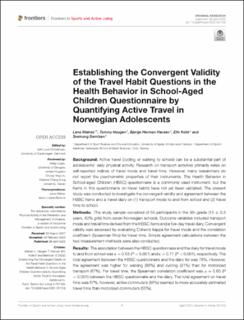Establishing the convergent validity of the travel habit questions in the health behavior in school-aged children questionnaire by quantifying active travel in Norwegian adolescents
Peer reviewed, Journal article
Published version
Permanent lenke
https://hdl.handle.net/11250/3010136Utgivelsesdato
2022Metadata
Vis full innførselSamlinger
- Artikler / Articles [2119]
- Publikasjoner fra Cristin [1107]
Originalversjon
Frontiers in Sports and Active Living. 2022, 4, Artikkel 761723. 10.3389/fspor.2022.761723Sammendrag
Background: Active travel (cycling or walking to school) can be a substantial part of adolescents' daily physical activity. Research on transport activities primarily relies on self-reported indices of travel mode and travel time. However, many researchers do not report the psychometric properties of their instruments. The Health Behavior in School-aged Children (HBSC) questionnaire is a commonly used instrument, but the items in this questionnaire on travel habits have not yet been validated. The present study was conducted to investigate the convergent validity and agreement between the HBSC items and a travel diary on (1) transport mode to and from school and (2) travel time to school.
Methods: The study sample consisted of 50 participants in the 9th grade (15 ± 0.3 years, 62% girls) from seven Norwegian schools. Outcome variables included transport mode and travel time derived from the HBSC items and a five-day travel diary. Convergent validity was assessed by evaluating Cohen's kappa for travel mode and the correlation coefficient (Spearman Rho) for travel time. Simple agreement calculations between the two measurement methods were also conducted.
Results: The association between the HBSC questionnaire and the diary for travel mode to and from school was κ = 0.63 (P < 0.001) and κ = 0.77 (P < 0.001), respectively. The total agreement between the HBSC questionnaire and the diary for was 78%. However, the agreement was higher for walking (88%) and cycling (91%) than for motorized transport (67%). For travel time, the Spearman correlation coefficient was ρ = 0.60 (P < 0.001) between the HBSC questionnaire and the diary. The total agreement on travel time was 67%; however, active commuters (86%) seemed to more accurately estimated travel time than motorized commuters (55%).
Beskrivelse
This is an open-access article distributed under the terms of the Creative Commons Attribution License (CC BY). The use, distribution or reproduction in other forums is permitted, provided the original author(s) and the copyright owner(s) are credited and that the original publication in this journal is cited, in accordance with accepted academic practice. No use, distribution or reproduction is permitted which does not comply with these terms.
